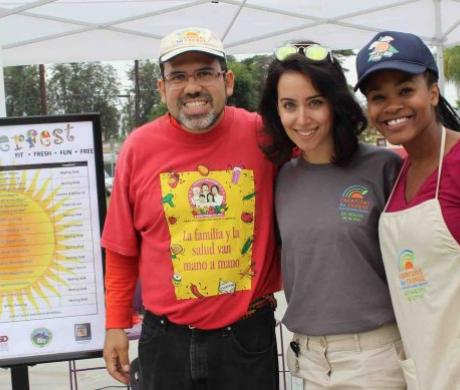Supporting Our Future: Early Childhood Policies in General Plans
Nina Alcaraz is senior policy, advocacy and communications manager for First 5 Monterey County and can be reached at nina@first5monterey.org. Michelle Slade, Carmen Gil and Rene Mendez of First 5 Monterey County also contributed to this article.
Years ago, the City of Gonzales in Monterey County recognized that investing in its youngest residents would not only meet current needs, but would also benefit generations to come. Gonzales worked with residents of all ages, city and county agency staff, local business leaders and subject matter experts to create meaningful change for its youngest children.
The city also looked for relevant insights from existing research. Numerous studies indicate that a critically important window of opportunity for development exists for children between birth and age 5. In the first five years of a child’s life, key brain connections are made that shape lifelong learning. According to Harvard University’s Center for the Developing Child, “Early experiences affect the development of brain architecture, which in turn provides the foundation for all future learning, behavior and health.” Because nearly 85 percent of brain development occurs in the first five years of life, taking steps to support young children’s development is critical — yet only 14 percent of public education dollars are spent on early childhood education in the United States.
The Importance of Early Childhood Development
How we nurture and support our children today not only addresses their current needs but also affects their future success in school and in life. Parents, caregivers and communities can have a significant, positive effect on children’s early experiences that lay the foundation for achievement, success and happiness. Nobel Laureate James J. Heckman said, “The highest rate of return in early childhood development comes from investing as early as possible, from birth through age 5.”
Preventive programs and services for young children make a significant difference over a lifetime and help our most vulnerable children by closing the “opportunity gap.” These investments in early childhood also help create safe and healthy communities with fewer students held back in school or involved in crime, increased rates of high school and college graduation and higher salaries when students enter the workforce. Comprehensive, high quality, “birth-to-5” early childhood programs for disadvantaged children yield up to a 13 percent return on investment through better education and economic, health and social outcomes.
Yet in Monterey County, like many regions nationwide, the reality contrasts starkly with the research. Parents with young children need reliable, quality early care for their children, but Monterey County statistics show that only 47 percent of working families with a child age 0 to 4 have access to child care and 41 percent of children ages 3 to 4 attend preschool. This limited access is not due to lack of interest — 87 percent of adults surveyed expressed a desire for their children to attend some form of child care or preschool. The most frequently cited reason for not attending was financial. Ultimately, without strong support for children in early childhood, schools suffer. In 2015, only 28 percent of kindergarteners in Monterey County had the skills needed to be optimally ready for kindergarten.
Gonzales Initiative Supports Children and Families
With high needs and limited resources, communities often encounter obstacles to finding solutions for young children and their families. But the City of Gonzales saw an opportunity and took steps to create a solutions framework, the Gonzales Youth 21st Century Success Initiative: A Cradle to Career Government, Education, Community and Workforce Partnership (GY21CSI). As part of the initiative, the city put policies and strategies into its General Plan that specifically support children and families. Gonzales adopted a Health and Wellness Element in 2018 that demonstrates the city’s commitment to the long-lasting value of early learning and maps out goals, policies and strategies to help meet the community’s long-term vision for its children.
General Plans provide a roadmap for the future and an opportunity to include early childhood development that meets the needs of residents, employees and employers. Gonzales customized its Health and Wellness Element to meet its residents’ unique needs. The city identified ways to integrate early childhood development into the fabric of its community and developed an implementation plan that outlines how quality early childhood programming will be achieved, emphasizing collaborative partnerships to help meet the goals.
The Building Blocks of Developing Policies
How does a city go from limited policies that support young children to building a Health and Wellness Element that acknowledges the importance of early childhood policies? Gonzales turned to its community and experts in the field of early learning. First, the city partnered with the Monterey County Health Department (MCHD) program Health in All Policies, which encourages incorporating health considerations into decisionmaking. The group took the lead in helping Gonzales find ways to inform its Health and Wellness Element. The first step involved broad community engagement using focus groups, town halls, interviews and community conversations — and a resident committee that helped develop the policy language.
For early childhood policies in the Health and Wellness Element, Gonzales and MCHD partnered with early childhood experts from various organizations and initiatives, including First 5 Monterey County (for more information, see “About First 5” above). This collective work helped articulate specific language that addressed Gonzales’ community needs and could help create tangible change for children and families.
The adopted Health and Wellness Element includes early childhood policies that range from supporting the development of quality, affordable, accessible early child care to encouraging developers and larger commercial employers to support and/or provide child care. The element’s drafters also looked to social investments through innovative practices that support families, such as developer fees used to support families’ holistic needs through family resource centers.
Gonzales used the policies in the approved Health and Wellness Element to identify funding within the city’s budget to support in-home, license-exempt child care providers who deliver a large portion of the child care in the city. With just 84 day care slots available in Gonzales, most working parents whose children need day care leave them with family members (often grandmothers) or friends who typically lack training in early childhood development. A city recreation program now hosts a playgroup for “Family, Friend and Neighbor” child care providers that is designed to help participants build connections, develop an understanding of early childhood development and learn new techniques of play-based learning with children. The city has also incorporated family-centric messaging into its social marketing campaigns and all city-sponsored events.
Including early childhood development policies in General Plans demonstrates local governments’ understanding of the long-lasting value of early learning. The City of Gonzales offers an example of how local communities can prioritize early childhood in long-term planning to ensure that all children — and their communities — can thrive.
Hear More About This Topic at the Annual Conference
Interested in learning more? Don’t miss the session “You Can Do It! Early Childhood Policies in General Plans” at the League of California Cities 2019 Annual Conference & Expo, 8:00 a.m.–12:15 p.m., Friday, Oct.18. For location details, see the conference brochure or mobile device app.
Representatives from the City of Gonzales, First 5 Monterey County and the Monterey County Health Department will showcase the Gonzales General Plan Health and Wellness Element as an example of how to include early childhood, prevention and health language in a General Plan to meet community needs and develop policies and investment strategies that will make a difference today and for generations to come. Panelists will share lessons learned, community partnership strategies and examples of early childhood policy language. Participants will have the opportunity to strategize and innovate for their own community in this interactive session.
About First 5
First 5 California is dedicated to improving the lives of California’s young children and their families through a comprehensive system of education, health services, child care and other crucial programs. Funding for First 5 comes from Proposition 10 (1998), which added a 50-cent tax to each pack of cigarettes sold. First 5 California distributes funds to local communities through the state’s 58 individual counties, all of which have created their own local First 5 county commissions.
This article appears in the August 2019 issue of Western City
Did you like what you read here? Subscribe to Western City







